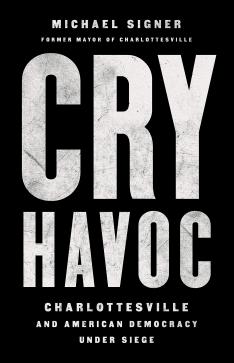Cry Havoc: Charlottesville and American Democracy Under Siege (PublicAffairs) is then- Charlottesville mayor Michael Signer ’95’s reflection on the rally and the governmental response to it. A lawyer and political scientist by trade, Signer reflects on the balance between supporting free speech and public order and the need for civility and understanding amid extremism.
The author: Michael Signer ’95 is a public scholar and practicing attorney who was the mayor of Charlottesville from 2016-2018. He is the author of Demagogue: The Fight to Save Democracy from Its Worst Enemies and Becoming Madison: The Extraordinary Origins of the Least Likely Founding Father.Opening lines: What happened on the weekend of August 11-12, 2017, in Charlottesville, Virginia, was so horrific, was such a tear in the fabric of a small city’s ordinary experience, that it strains one’s power to describe. Hordes of white nationalists invaded the University of Virginia and then the Downtown Mall of the city, ostensibly to support the preservation of a statue of Confederate general Robert E. Lee. They clashed violently with counterprotesters along the way before a neo-Nazi terrorist drove his car into a crowd of counterprotesters, killing one young woman and injuring nineteen others.
The events were cinematic, to be sure, quickly branded into the nation’s consciousness by a Vice News documentary that went viral. The video showed muscular, violent men chanting “Jews will not replace us” as they carried torches on the fabled “Grounds” of the university. It showed a melee near the quaint Downtown Mall, where right-wing activists, bearing handmade shields and helmets, cracked flagpoles onto left-wing counterprotesters and sent fists flying into faces. One counterprotester used a spray can as a torch; a white protester fired a handgun toward a black counterprotester (luckily, not hitting him). Others hurled newspaper boxes. Waves of neo-Nazis, wearing swastika apparel, rolled on foot into anti-racist activists wearing Black Lives Matter shirts. People fell onto concrete and blacktop, thrashing against each other. As the violence spread like wildfire, police from both the state and the city stood by impassively.
These scenes are available to anyone who types “Charlottesville” into Google.
But what stays in my memory were not these broad canvases of violence and suffering. It is instead individual vignettes, which I can slow down and replay in my mind, of men and women brought to anxiety and violence by extremism.
After taking an early-morning swim at the gym on Monticello Avenue, my friend Richard, an African American man in his late fifties who grew up in segregated Charlottesville, watching a militia of neo-Nazis unload from a rented tour bus. As they adjusted their shields and helmets, holding assault rifles, Richard said, they were smiling and cheerful, “like they were going to a party.” Fearing for his safety, he retreated quickly back into the building from which he had come.
As neo-Nazis marched with tiki torches through Thomas Jefferson’s famed “Lawn” at the University of Virginia, around Jefferson’s Rotunda, and up to a statue of Jefferson, a group of UVA students linking arms and surrounding the statue, despite the melee unleashed on them, with pepper spray, punches, and blood.
At the rally, a man hurling a punch at a young female counterprotester as he walked by, knocking her back several feet. The untrammeled testosterone, the shocking violence, the mayhem in that blatant, unashamed act of battery.
Reviews: “Charlottesville, Virginia, my hometown, is now an emblem and a microcosm of the tensions and divisions roiling our nation. Mayor Michael Signer found himself in the center of a growing brushfire that culminated in the murderous Unite the Right demonstration in August 2017. Here he tells a difficult, unsparing, but often engrossing story that illuminates just how hard it can be to face our past while also finding a healing and hopeful path forward.” – Anne-Marie Slaughter ’80, CEO, New America


